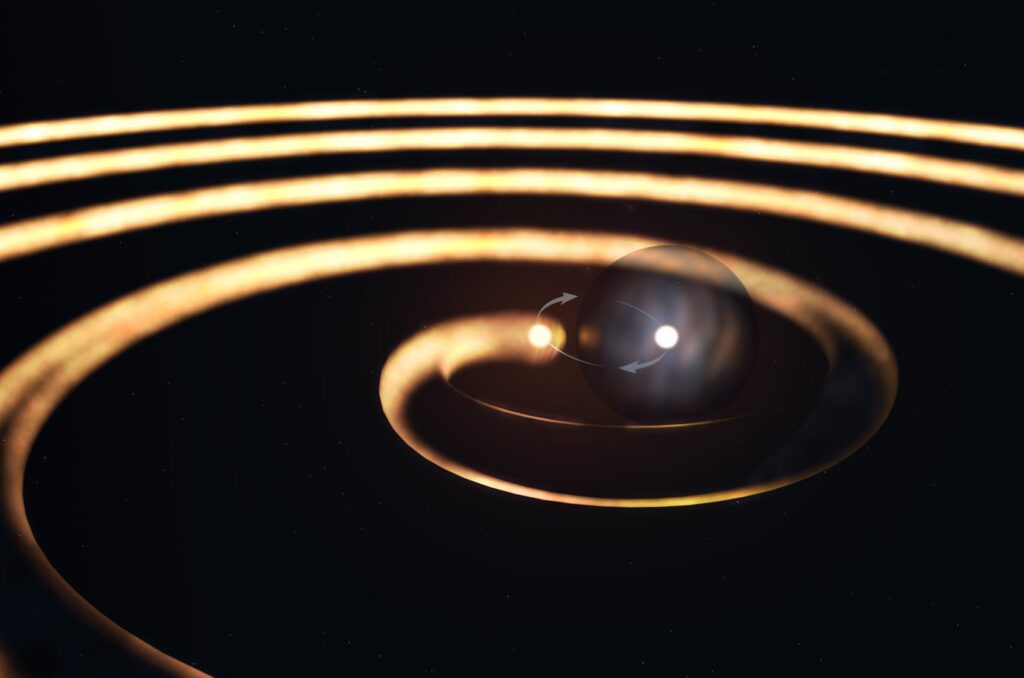The authors say they “were puzzled at first” until they finally realized that they “were seeing something new”.
The findings are published in the journal Nature and were obtained using infrared photos of the binary star system WR140 acquired over a 16-year period.
NASA’s James Webb Space Telescope (JWST) was used in a separate investigation of WR140, also published in Nature Astronomy, and was able to see considerably deeper, capturing an image of not just one accelerating dust plume but nearly twenty, nested inside each other like a large set of onion skins.
WR140 is made up of a large Wolf-Rayet star and an even more massive blue supergiant star that are gravitationally trapped in an eight-year orbit.
This binary star in the constellation Cygnus has been studied for two decades using one of the world’s largest optical telescopes at Hawaii’s Keck Observatory.

WR140 blows out plumes of dust that span thousands of times the distance between the Earth and the Sun. Every eight years, these dust plumes appear, providing astronomers with a rare chance to study the effects of starlight on matter.
It is well understood that light has momentum and exerts a push on matter known as radiation pressure. Astronomers frequently observe the result of this phenomenon in the form of matter speeding across the cosmos, but it has been difficult to capture this phenomenon in action. In a stellar setting like this, direct recording of acceleration caused by forces other than gravity is extremely unusual.
“It’s hard to see starlight causing acceleration because the force fades with distance, and other forces quickly take over,” says first author Yinuo Han. “To witness acceleration at the level that it becomes measurable, the material needs to be reasonably close to the star or the source of the radiation pressure needs to be extra strong. WR140 is a binary star whose ferocious radiation field supercharges these effects, placing them within reach of our high-precision data.”
All stars have stellar winds, but Wolf-Rayet stars can have winds that are more like hurricanes. Elements in the wind, like carbon, turn into soot, which stays hot enough to shine brightly in the infrared. Similar to smoke in the wind, this provides telescopes with something to observe.
Interferometry served as a zoom lens for the 10-meter Keck telescope mirror, allowing the scientists to obtain sufficiently fine images of WR140 for the investigation.

Han and his crew discovered that the star’s dust does not stream out from it in a hazy ball with the wind. Instead, the dust originates on the surface of a cone-shaped shock front between the two stars, when the winds from the two stars collide.
The shock front rotates in sync with the circling binary star. Similar to how water droplets make a spiral in a lawn sprinkler, the sooty plume spirals around itself.
Researchers discovered that WR140 exhibits additional capabilities. The two stars don’t move in a circle, but rather in an elliptical pattern, and as the binary approaches and leaves the point of closest approach, dust production starts and stops. By modeling these impacts into the three-dimensional geometry of the dust plume, astronomers were able to determine the three-dimensional position of dust features.
“Like clockwork, this star puffs out sculpted smoke rings every eight years, with all this wonderful physics written then inflated in the wind like a banner for us to read,” adds co-author Professor Peter Tuthill. “Eight years later as the binary returns in its orbit, another appears the same as the one before, streaming out into space inside the bubble of the previous one, like a set of giant nested Russian dolls.”

This Wolf-Rayet provided astronomers with a one-of-a-kind laboratory for studying the acceleration zone due to the predictability and expansiveness of the dust it generates.
“In the absence of external forces, each dust spiral should expand at a constant speed,” adds Han, who is also a co-author on the JWST paper. “We were puzzled at first because we could not get our model to fit the observations, until we finally realised that we were seeing something new. The data did not fit because the expansion speed wasn’t constant, but rather that it was accelerating. We’d caught that for the first time on camera.”
“In one sense, we always knew this must be the reason for the outflow, but I never dreamed we’d be able to see the physics at work like this,” adds Tuthill. “When I look at the data now, I see WR140’s plume unfurling a like giant sail made of dust. When it catches the photon wind streaming from the star, like a yacht catching a gust, it makes a sudden leap forward.”
Now that JWST is up and running, scientists have a great opportunity to learn more about WR140 and other related systems.
According to Ryan Lau, who oversaw the JWST investigation, “the Webb telescope offers new extremes of stability and sensitivity.”
“We’ll now be able to make observations like this much more easily than from the ground, opening a new window into the world of Wolf-Rayet physics.”
Source: 10.1038/s41586-022-05155-5
Image Credit: NASA, ESA, CSA, STSCI, JPL-CALTECH
You were reading: Stunning New Images Show ‘Hard To See Starlight’ In Action
